Nike's Operations Management: ERP Implementation & DESTEP Analysis
VerifiedAdded on 2023/06/04
|14
|3552
|108
Case Study
AI Summary
This case study delves into Nike's operations management, focusing on the transformation processes, the four Vs (volume, variety, variation, and visibility), and the implementation of a Single Instance Strategy for its ERP system. It examines Nike's characteristics in terms of cost, dependability, flexibility, quality, and speed, and identifies order winners and qualifying factors based on DESTEP analysis. The case study further explores the process types and layout types used by Nike, along with the production-to-demand ratio and applicable capacity management modes. It also discusses Nike's inventory management model and analyzes the changes in activities arising from outsourcing, comparing the advantages and disadvantages of customized systems and strategic and tactical critical success factors for successful ERP implementation. The study highlights how Nike's IT framework manages the supply chain, impacting material and product flow.
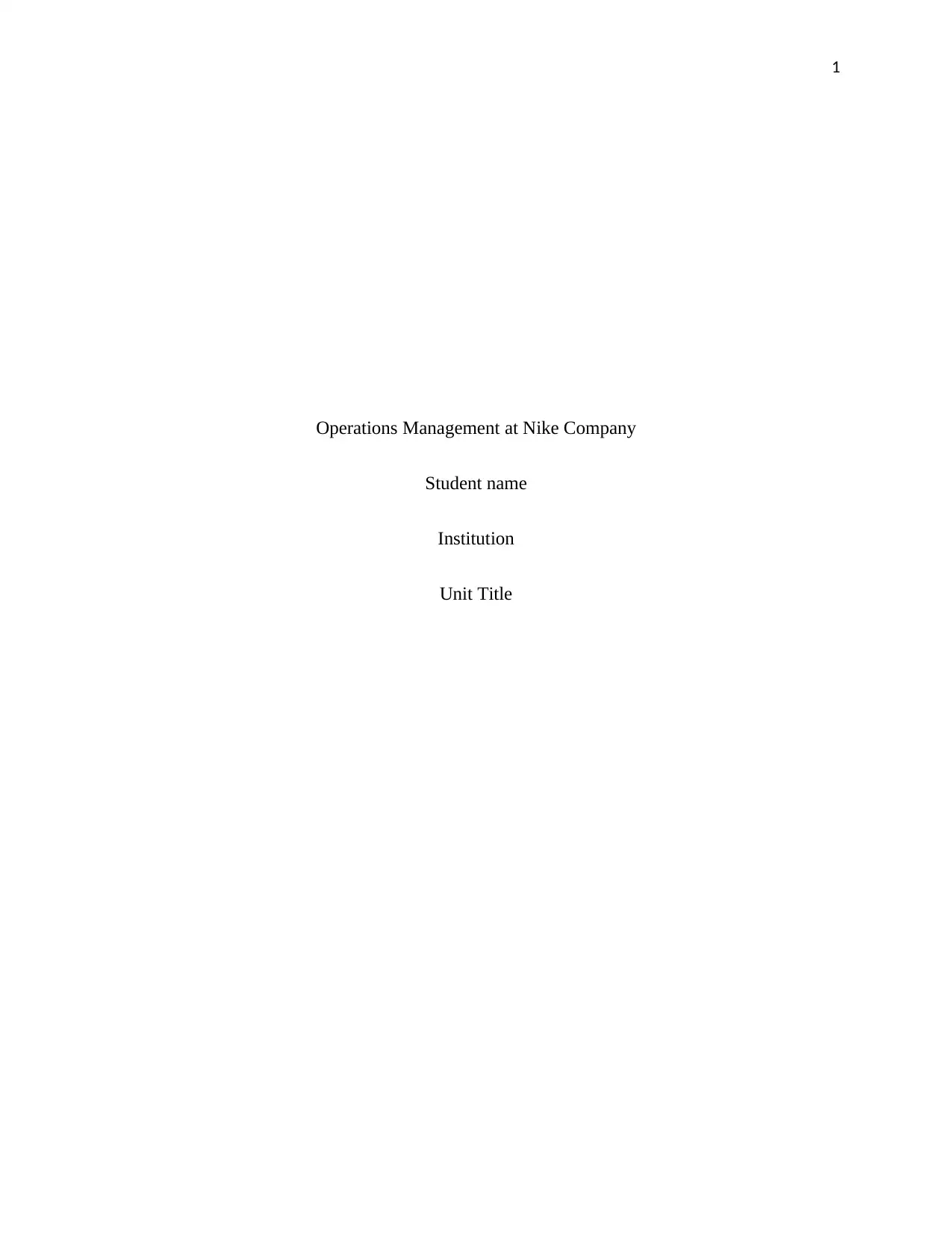
1
Operations Management at Nike Company
Student name
Institution
Unit Title
Operations Management at Nike Company
Student name
Institution
Unit Title
Secure Best Marks with AI Grader
Need help grading? Try our AI Grader for instant feedback on your assignments.

2
Table of Contents
Executive Summary.....................................................................................................................................3
Introduction.................................................................................................................................................3
Transformation Processes........................................................................................................................3
The Four Vs.............................................................................................................................................4
Order Winners from the DESTEP analysis for Nike Company...............................................................5
Qualifying Factors from the DESTEP analysis for Nike Company.........................................................7
Process Types for Nike............................................................................................................................7
Production to Demand Ratio...................................................................................................................7
Modes of Capacity Management applicable for Nike..............................................................................8
Model for Inventory management...........................................................................................................8
Single Instance Strategy..........................................................................................................................9
Changes in Activities arising from Outsourcing for Nike Company........................................................9
Comparison of Advantages and disadvantages of customized systems.................................................10
Strategic and tactical critical success factors with regard to successful ERP implementation...............11
Conclusion.............................................................................................................................................11
References.............................................................................................................................................13
Table of Contents
Executive Summary.....................................................................................................................................3
Introduction.................................................................................................................................................3
Transformation Processes........................................................................................................................3
The Four Vs.............................................................................................................................................4
Order Winners from the DESTEP analysis for Nike Company...............................................................5
Qualifying Factors from the DESTEP analysis for Nike Company.........................................................7
Process Types for Nike............................................................................................................................7
Production to Demand Ratio...................................................................................................................7
Modes of Capacity Management applicable for Nike..............................................................................8
Model for Inventory management...........................................................................................................8
Single Instance Strategy..........................................................................................................................9
Changes in Activities arising from Outsourcing for Nike Company........................................................9
Comparison of Advantages and disadvantages of customized systems.................................................10
Strategic and tactical critical success factors with regard to successful ERP implementation...............11
Conclusion.............................................................................................................................................11
References.............................................................................................................................................13
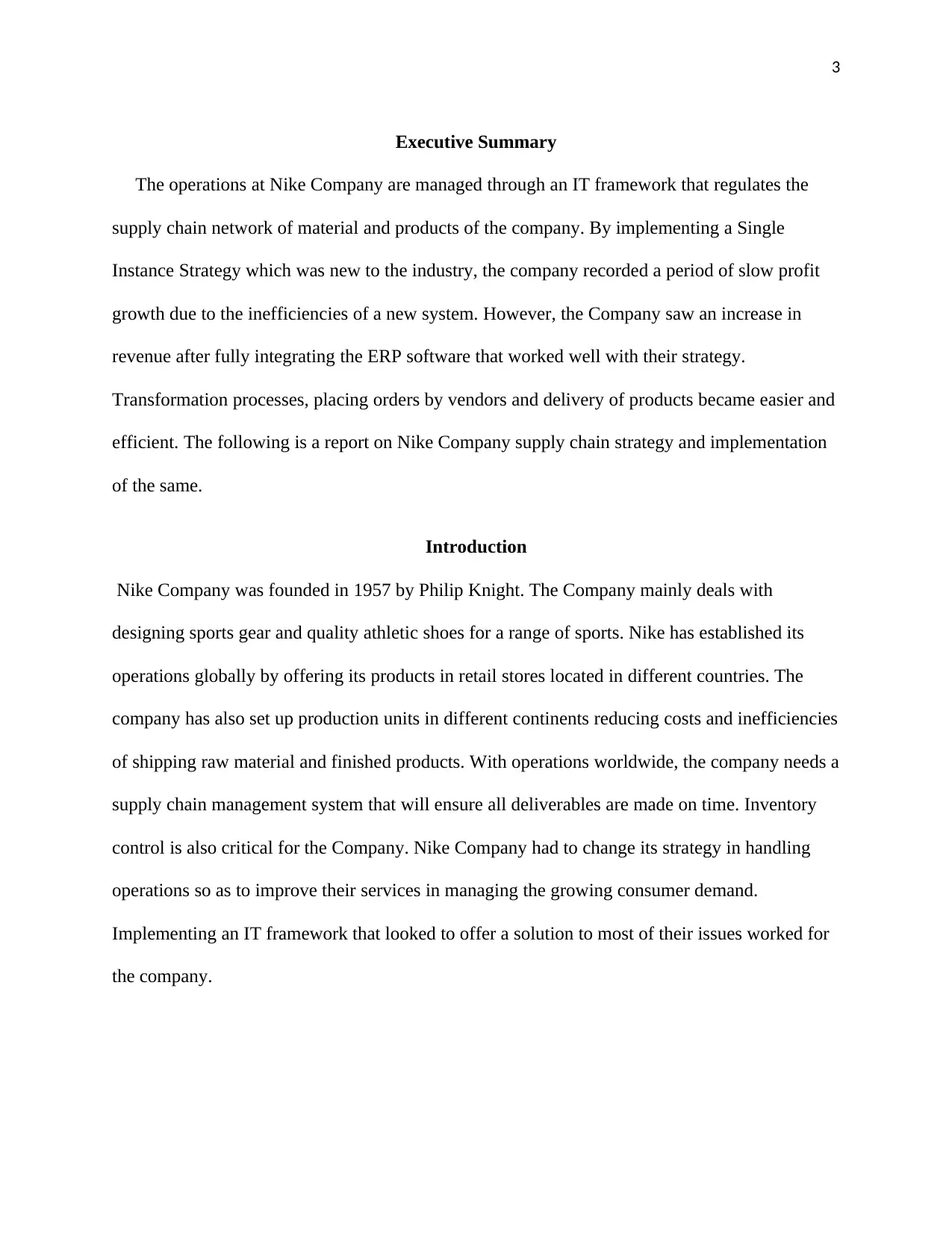
3
Executive Summary
The operations at Nike Company are managed through an IT framework that regulates the
supply chain network of material and products of the company. By implementing a Single
Instance Strategy which was new to the industry, the company recorded a period of slow profit
growth due to the inefficiencies of a new system. However, the Company saw an increase in
revenue after fully integrating the ERP software that worked well with their strategy.
Transformation processes, placing orders by vendors and delivery of products became easier and
efficient. The following is a report on Nike Company supply chain strategy and implementation
of the same.
Introduction
Nike Company was founded in 1957 by Philip Knight. The Company mainly deals with
designing sports gear and quality athletic shoes for a range of sports. Nike has established its
operations globally by offering its products in retail stores located in different countries. The
company has also set up production units in different continents reducing costs and inefficiencies
of shipping raw material and finished products. With operations worldwide, the company needs a
supply chain management system that will ensure all deliverables are made on time. Inventory
control is also critical for the Company. Nike Company had to change its strategy in handling
operations so as to improve their services in managing the growing consumer demand.
Implementing an IT framework that looked to offer a solution to most of their issues worked for
the company.
Executive Summary
The operations at Nike Company are managed through an IT framework that regulates the
supply chain network of material and products of the company. By implementing a Single
Instance Strategy which was new to the industry, the company recorded a period of slow profit
growth due to the inefficiencies of a new system. However, the Company saw an increase in
revenue after fully integrating the ERP software that worked well with their strategy.
Transformation processes, placing orders by vendors and delivery of products became easier and
efficient. The following is a report on Nike Company supply chain strategy and implementation
of the same.
Introduction
Nike Company was founded in 1957 by Philip Knight. The Company mainly deals with
designing sports gear and quality athletic shoes for a range of sports. Nike has established its
operations globally by offering its products in retail stores located in different countries. The
company has also set up production units in different continents reducing costs and inefficiencies
of shipping raw material and finished products. With operations worldwide, the company needs a
supply chain management system that will ensure all deliverables are made on time. Inventory
control is also critical for the Company. Nike Company had to change its strategy in handling
operations so as to improve their services in managing the growing consumer demand.
Implementing an IT framework that looked to offer a solution to most of their issues worked for
the company.
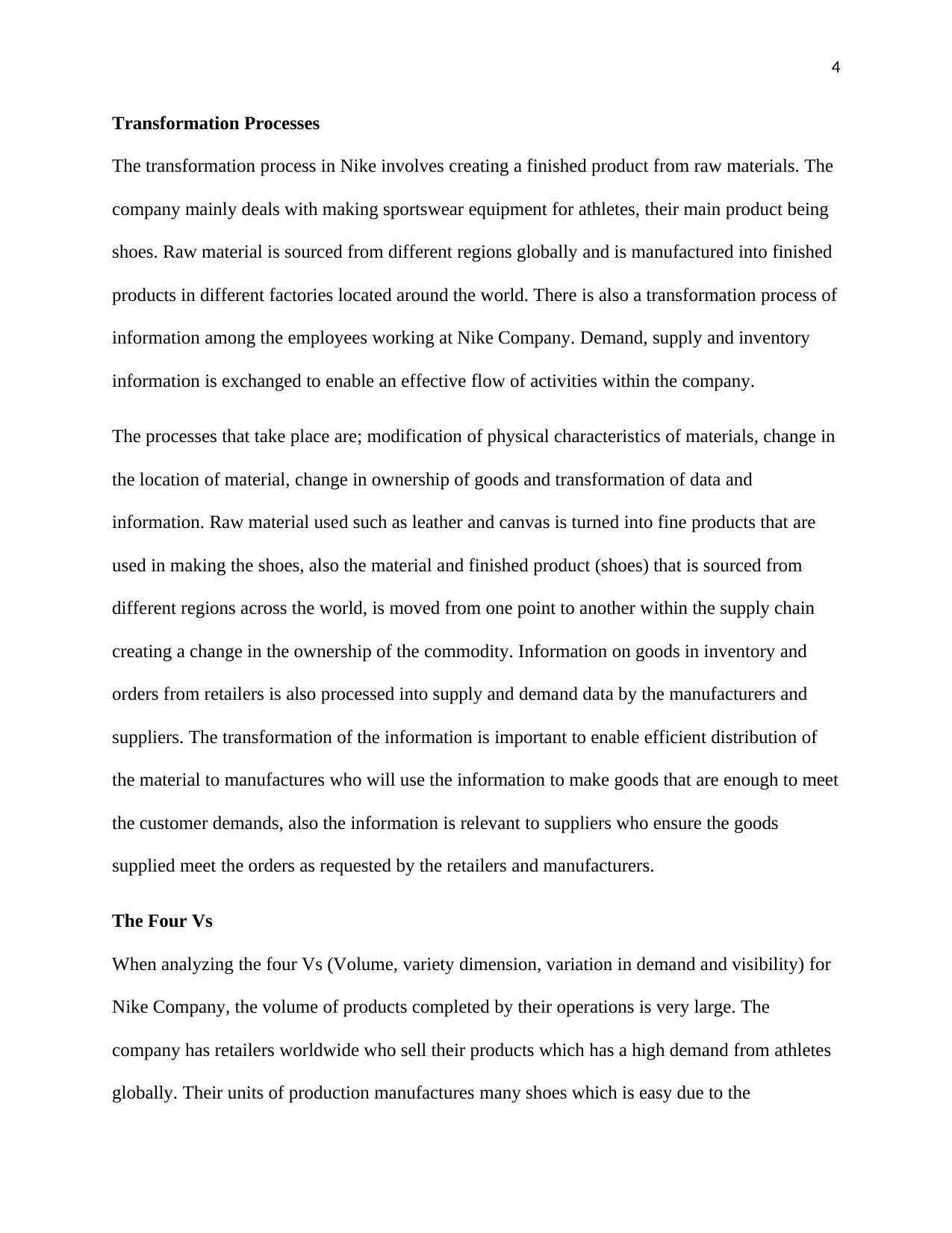
4
Transformation Processes
The transformation process in Nike involves creating a finished product from raw materials. The
company mainly deals with making sportswear equipment for athletes, their main product being
shoes. Raw material is sourced from different regions globally and is manufactured into finished
products in different factories located around the world. There is also a transformation process of
information among the employees working at Nike Company. Demand, supply and inventory
information is exchanged to enable an effective flow of activities within the company.
The processes that take place are; modification of physical characteristics of materials, change in
the location of material, change in ownership of goods and transformation of data and
information. Raw material used such as leather and canvas is turned into fine products that are
used in making the shoes, also the material and finished product (shoes) that is sourced from
different regions across the world, is moved from one point to another within the supply chain
creating a change in the ownership of the commodity. Information on goods in inventory and
orders from retailers is also processed into supply and demand data by the manufacturers and
suppliers. The transformation of the information is important to enable efficient distribution of
the material to manufactures who will use the information to make goods that are enough to meet
the customer demands, also the information is relevant to suppliers who ensure the goods
supplied meet the orders as requested by the retailers and manufacturers.
The Four Vs
When analyzing the four Vs (Volume, variety dimension, variation in demand and visibility) for
Nike Company, the volume of products completed by their operations is very large. The
company has retailers worldwide who sell their products which has a high demand from athletes
globally. Their units of production manufactures many shoes which is easy due to the
Transformation Processes
The transformation process in Nike involves creating a finished product from raw materials. The
company mainly deals with making sportswear equipment for athletes, their main product being
shoes. Raw material is sourced from different regions globally and is manufactured into finished
products in different factories located around the world. There is also a transformation process of
information among the employees working at Nike Company. Demand, supply and inventory
information is exchanged to enable an effective flow of activities within the company.
The processes that take place are; modification of physical characteristics of materials, change in
the location of material, change in ownership of goods and transformation of data and
information. Raw material used such as leather and canvas is turned into fine products that are
used in making the shoes, also the material and finished product (shoes) that is sourced from
different regions across the world, is moved from one point to another within the supply chain
creating a change in the ownership of the commodity. Information on goods in inventory and
orders from retailers is also processed into supply and demand data by the manufacturers and
suppliers. The transformation of the information is important to enable efficient distribution of
the material to manufactures who will use the information to make goods that are enough to meet
the customer demands, also the information is relevant to suppliers who ensure the goods
supplied meet the orders as requested by the retailers and manufacturers.
The Four Vs
When analyzing the four Vs (Volume, variety dimension, variation in demand and visibility) for
Nike Company, the volume of products completed by their operations is very large. The
company has retailers worldwide who sell their products which has a high demand from athletes
globally. Their units of production manufactures many shoes which is easy due to the
Secure Best Marks with AI Grader
Need help grading? Try our AI Grader for instant feedback on your assignments.
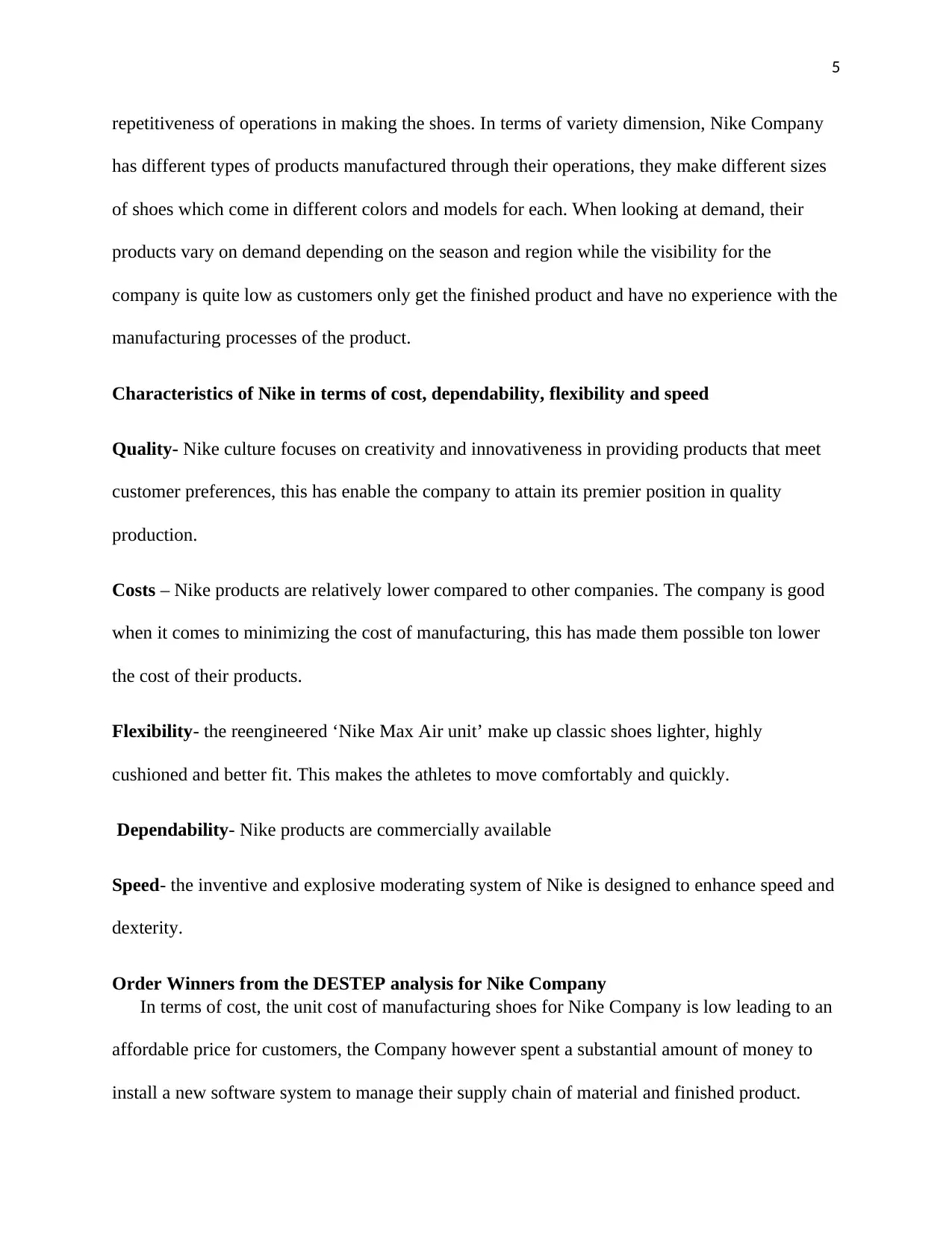
5
repetitiveness of operations in making the shoes. In terms of variety dimension, Nike Company
has different types of products manufactured through their operations, they make different sizes
of shoes which come in different colors and models for each. When looking at demand, their
products vary on demand depending on the season and region while the visibility for the
company is quite low as customers only get the finished product and have no experience with the
manufacturing processes of the product.
Characteristics of Nike in terms of cost, dependability, flexibility and speed
Quality- Nike culture focuses on creativity and innovativeness in providing products that meet
customer preferences, this has enable the company to attain its premier position in quality
production.
Costs – Nike products are relatively lower compared to other companies. The company is good
when it comes to minimizing the cost of manufacturing, this has made them possible ton lower
the cost of their products.
Flexibility- the reengineered ‘Nike Max Air unit’ make up classic shoes lighter, highly
cushioned and better fit. This makes the athletes to move comfortably and quickly.
Dependability- Nike products are commercially available
Speed- the inventive and explosive moderating system of Nike is designed to enhance speed and
dexterity.
Order Winners from the DESTEP analysis for Nike Company
In terms of cost, the unit cost of manufacturing shoes for Nike Company is low leading to an
affordable price for customers, the Company however spent a substantial amount of money to
install a new software system to manage their supply chain of material and finished product.
repetitiveness of operations in making the shoes. In terms of variety dimension, Nike Company
has different types of products manufactured through their operations, they make different sizes
of shoes which come in different colors and models for each. When looking at demand, their
products vary on demand depending on the season and region while the visibility for the
company is quite low as customers only get the finished product and have no experience with the
manufacturing processes of the product.
Characteristics of Nike in terms of cost, dependability, flexibility and speed
Quality- Nike culture focuses on creativity and innovativeness in providing products that meet
customer preferences, this has enable the company to attain its premier position in quality
production.
Costs – Nike products are relatively lower compared to other companies. The company is good
when it comes to minimizing the cost of manufacturing, this has made them possible ton lower
the cost of their products.
Flexibility- the reengineered ‘Nike Max Air unit’ make up classic shoes lighter, highly
cushioned and better fit. This makes the athletes to move comfortably and quickly.
Dependability- Nike products are commercially available
Speed- the inventive and explosive moderating system of Nike is designed to enhance speed and
dexterity.
Order Winners from the DESTEP analysis for Nike Company
In terms of cost, the unit cost of manufacturing shoes for Nike Company is low leading to an
affordable price for customers, the Company however spent a substantial amount of money to
install a new software system to manage their supply chain of material and finished product.

6
Nike Company is also dependable as it ensures that its products are delivered on time to the
retailers and the supply of required material to their production units is met. The Company is
also quite flexible in its operations as it adjusts its activities to meet the changing customer
requirements and meeting product demand which changes with seasons. The Company is also
flexible as it creates several different models of shoes and sportswear. When considering
quality, the operations at Nike Company ensure that their products meet the quality demanded by
their consumers, they deliver products based on the input and suggestions from their retailers and
customers. The speed of their operations in delivering their products is high. The Company
manufactures and ships their products globally to their retailers on time. They are also quick in
researching and developing a new product.
In terms of demographic aspect, Nike Company has established retail stores worldwide. This
allows the company to sell its products globally. The company has maintained a supply chain
that ensures all the retailers selling their merchandise have a steady supply of their products.
This ensures that consumer demand is meet. The company has also developed different
manufacturing plants across different nations in the world. This eases the running of operations
as raw material that is sourced from different regions is processed in the closest production unit.
Nike Company minimizes the costs and risks of shipping products between continents. Another
order winner for the company is their technological approach in running their activities. The
company deployed a Single Instance Strategy to control their supply chain system. The new
system ensures the supply of products on time allowing the company to satisfy customer
demands. The system which was not familiar in the industry, increased the competitive edge as
their counterparts in the sportswear industry are reluctant to embrace it, creating constraints in
their supply chain.
Nike Company is also dependable as it ensures that its products are delivered on time to the
retailers and the supply of required material to their production units is met. The Company is
also quite flexible in its operations as it adjusts its activities to meet the changing customer
requirements and meeting product demand which changes with seasons. The Company is also
flexible as it creates several different models of shoes and sportswear. When considering
quality, the operations at Nike Company ensure that their products meet the quality demanded by
their consumers, they deliver products based on the input and suggestions from their retailers and
customers. The speed of their operations in delivering their products is high. The Company
manufactures and ships their products globally to their retailers on time. They are also quick in
researching and developing a new product.
In terms of demographic aspect, Nike Company has established retail stores worldwide. This
allows the company to sell its products globally. The company has maintained a supply chain
that ensures all the retailers selling their merchandise have a steady supply of their products.
This ensures that consumer demand is meet. The company has also developed different
manufacturing plants across different nations in the world. This eases the running of operations
as raw material that is sourced from different regions is processed in the closest production unit.
Nike Company minimizes the costs and risks of shipping products between continents. Another
order winner for the company is their technological approach in running their activities. The
company deployed a Single Instance Strategy to control their supply chain system. The new
system ensures the supply of products on time allowing the company to satisfy customer
demands. The system which was not familiar in the industry, increased the competitive edge as
their counterparts in the sportswear industry are reluctant to embrace it, creating constraints in
their supply chain.
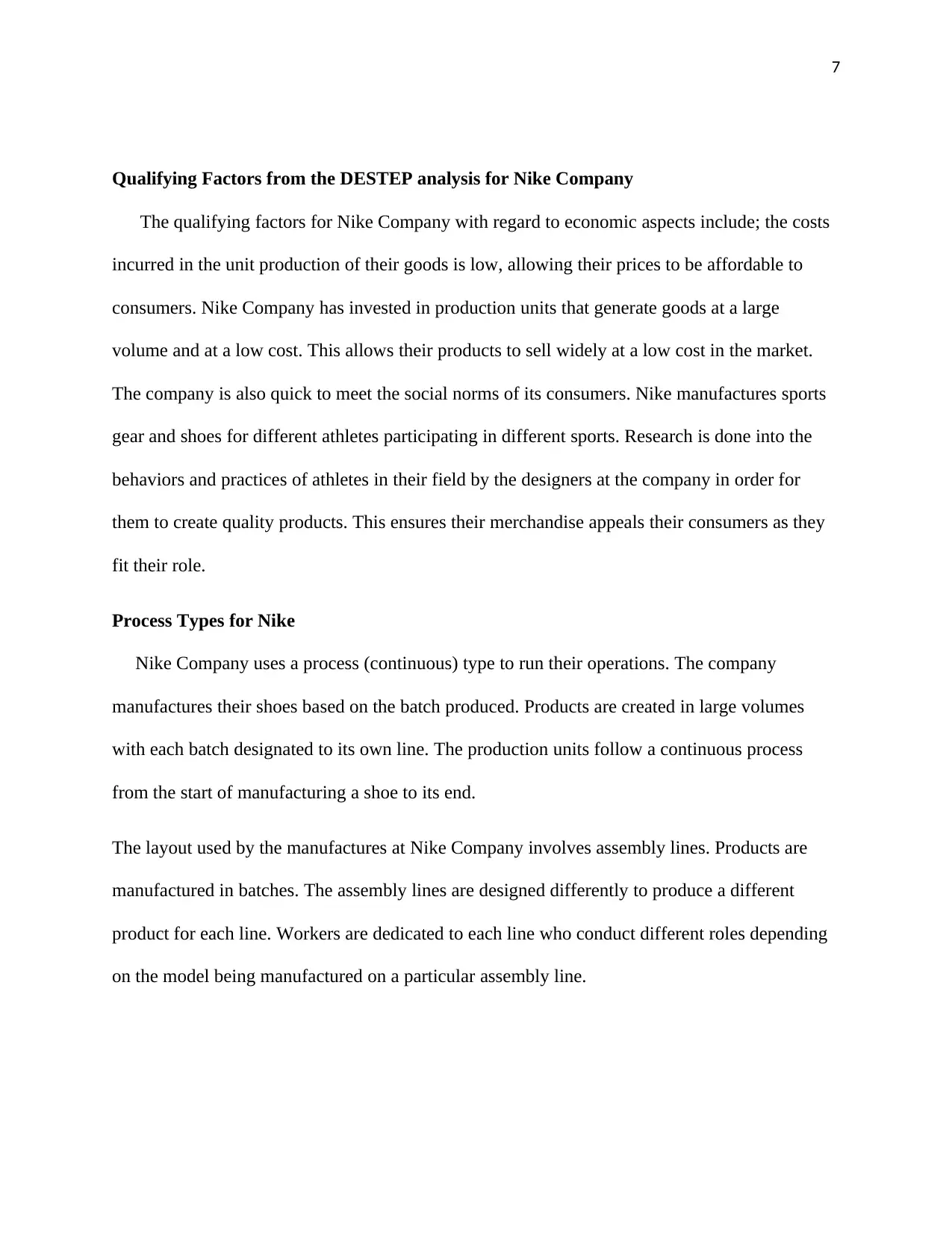
7
Qualifying Factors from the DESTEP analysis for Nike Company
The qualifying factors for Nike Company with regard to economic aspects include; the costs
incurred in the unit production of their goods is low, allowing their prices to be affordable to
consumers. Nike Company has invested in production units that generate goods at a large
volume and at a low cost. This allows their products to sell widely at a low cost in the market.
The company is also quick to meet the social norms of its consumers. Nike manufactures sports
gear and shoes for different athletes participating in different sports. Research is done into the
behaviors and practices of athletes in their field by the designers at the company in order for
them to create quality products. This ensures their merchandise appeals their consumers as they
fit their role.
Process Types for Nike
Nike Company uses a process (continuous) type to run their operations. The company
manufactures their shoes based on the batch produced. Products are created in large volumes
with each batch designated to its own line. The production units follow a continuous process
from the start of manufacturing a shoe to its end.
The layout used by the manufactures at Nike Company involves assembly lines. Products are
manufactured in batches. The assembly lines are designed differently to produce a different
product for each line. Workers are dedicated to each line who conduct different roles depending
on the model being manufactured on a particular assembly line.
Qualifying Factors from the DESTEP analysis for Nike Company
The qualifying factors for Nike Company with regard to economic aspects include; the costs
incurred in the unit production of their goods is low, allowing their prices to be affordable to
consumers. Nike Company has invested in production units that generate goods at a large
volume and at a low cost. This allows their products to sell widely at a low cost in the market.
The company is also quick to meet the social norms of its consumers. Nike manufactures sports
gear and shoes for different athletes participating in different sports. Research is done into the
behaviors and practices of athletes in their field by the designers at the company in order for
them to create quality products. This ensures their merchandise appeals their consumers as they
fit their role.
Process Types for Nike
Nike Company uses a process (continuous) type to run their operations. The company
manufactures their shoes based on the batch produced. Products are created in large volumes
with each batch designated to its own line. The production units follow a continuous process
from the start of manufacturing a shoe to its end.
The layout used by the manufactures at Nike Company involves assembly lines. Products are
manufactured in batches. The assembly lines are designed differently to produce a different
product for each line. Workers are dedicated to each line who conduct different roles depending
on the model being manufactured on a particular assembly line.
Paraphrase This Document
Need a fresh take? Get an instant paraphrase of this document with our AI Paraphraser
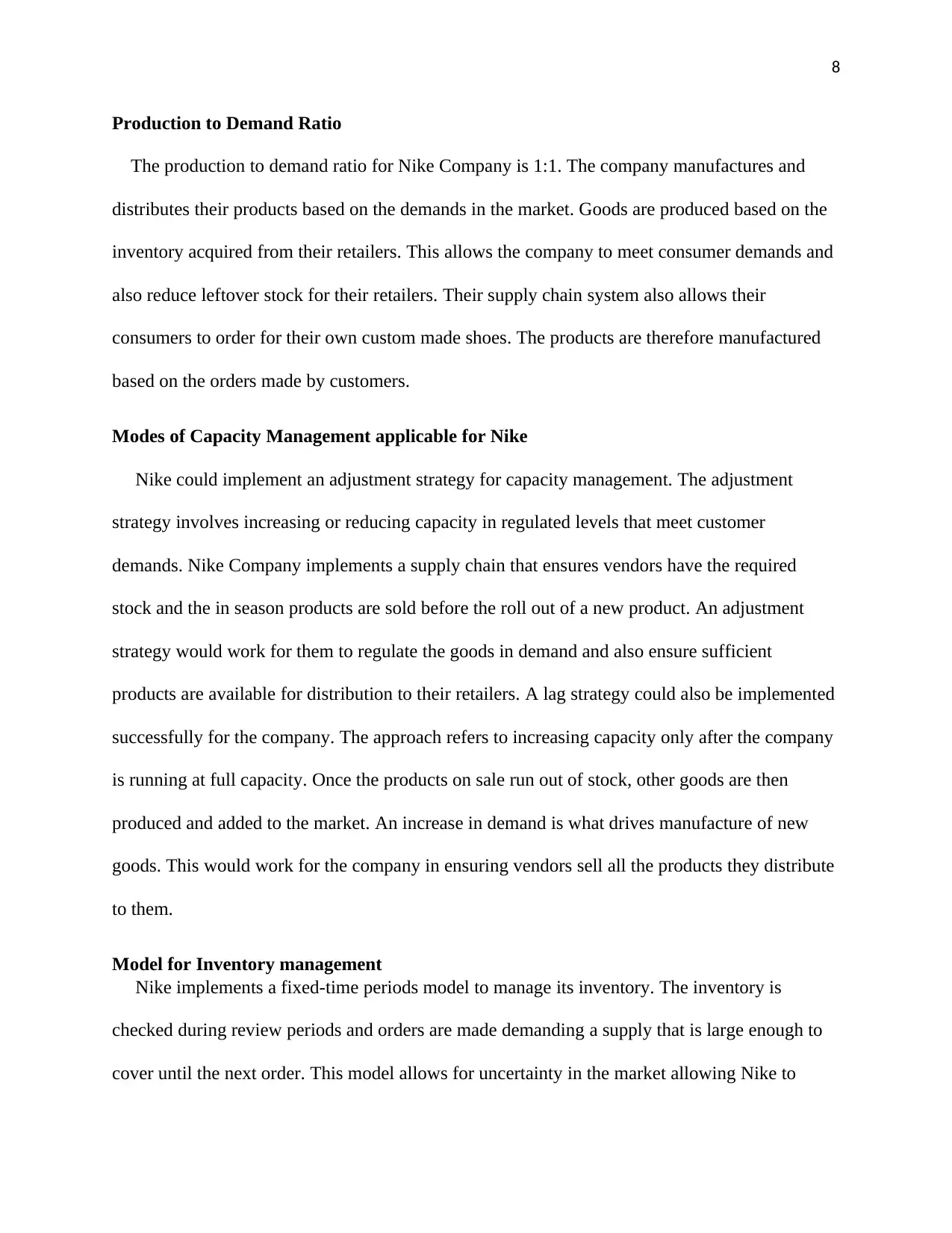
8
Production to Demand Ratio
The production to demand ratio for Nike Company is 1:1. The company manufactures and
distributes their products based on the demands in the market. Goods are produced based on the
inventory acquired from their retailers. This allows the company to meet consumer demands and
also reduce leftover stock for their retailers. Their supply chain system also allows their
consumers to order for their own custom made shoes. The products are therefore manufactured
based on the orders made by customers.
Modes of Capacity Management applicable for Nike
Nike could implement an adjustment strategy for capacity management. The adjustment
strategy involves increasing or reducing capacity in regulated levels that meet customer
demands. Nike Company implements a supply chain that ensures vendors have the required
stock and the in season products are sold before the roll out of a new product. An adjustment
strategy would work for them to regulate the goods in demand and also ensure sufficient
products are available for distribution to their retailers. A lag strategy could also be implemented
successfully for the company. The approach refers to increasing capacity only after the company
is running at full capacity. Once the products on sale run out of stock, other goods are then
produced and added to the market. An increase in demand is what drives manufacture of new
goods. This would work for the company in ensuring vendors sell all the products they distribute
to them.
Model for Inventory management
Nike implements a fixed-time periods model to manage its inventory. The inventory is
checked during review periods and orders are made demanding a supply that is large enough to
cover until the next order. This model allows for uncertainty in the market allowing Nike to
Production to Demand Ratio
The production to demand ratio for Nike Company is 1:1. The company manufactures and
distributes their products based on the demands in the market. Goods are produced based on the
inventory acquired from their retailers. This allows the company to meet consumer demands and
also reduce leftover stock for their retailers. Their supply chain system also allows their
consumers to order for their own custom made shoes. The products are therefore manufactured
based on the orders made by customers.
Modes of Capacity Management applicable for Nike
Nike could implement an adjustment strategy for capacity management. The adjustment
strategy involves increasing or reducing capacity in regulated levels that meet customer
demands. Nike Company implements a supply chain that ensures vendors have the required
stock and the in season products are sold before the roll out of a new product. An adjustment
strategy would work for them to regulate the goods in demand and also ensure sufficient
products are available for distribution to their retailers. A lag strategy could also be implemented
successfully for the company. The approach refers to increasing capacity only after the company
is running at full capacity. Once the products on sale run out of stock, other goods are then
produced and added to the market. An increase in demand is what drives manufacture of new
goods. This would work for the company in ensuring vendors sell all the products they distribute
to them.
Model for Inventory management
Nike implements a fixed-time periods model to manage its inventory. The inventory is
checked during review periods and orders are made demanding a supply that is large enough to
cover until the next order. This model allows for uncertainty in the market allowing Nike to
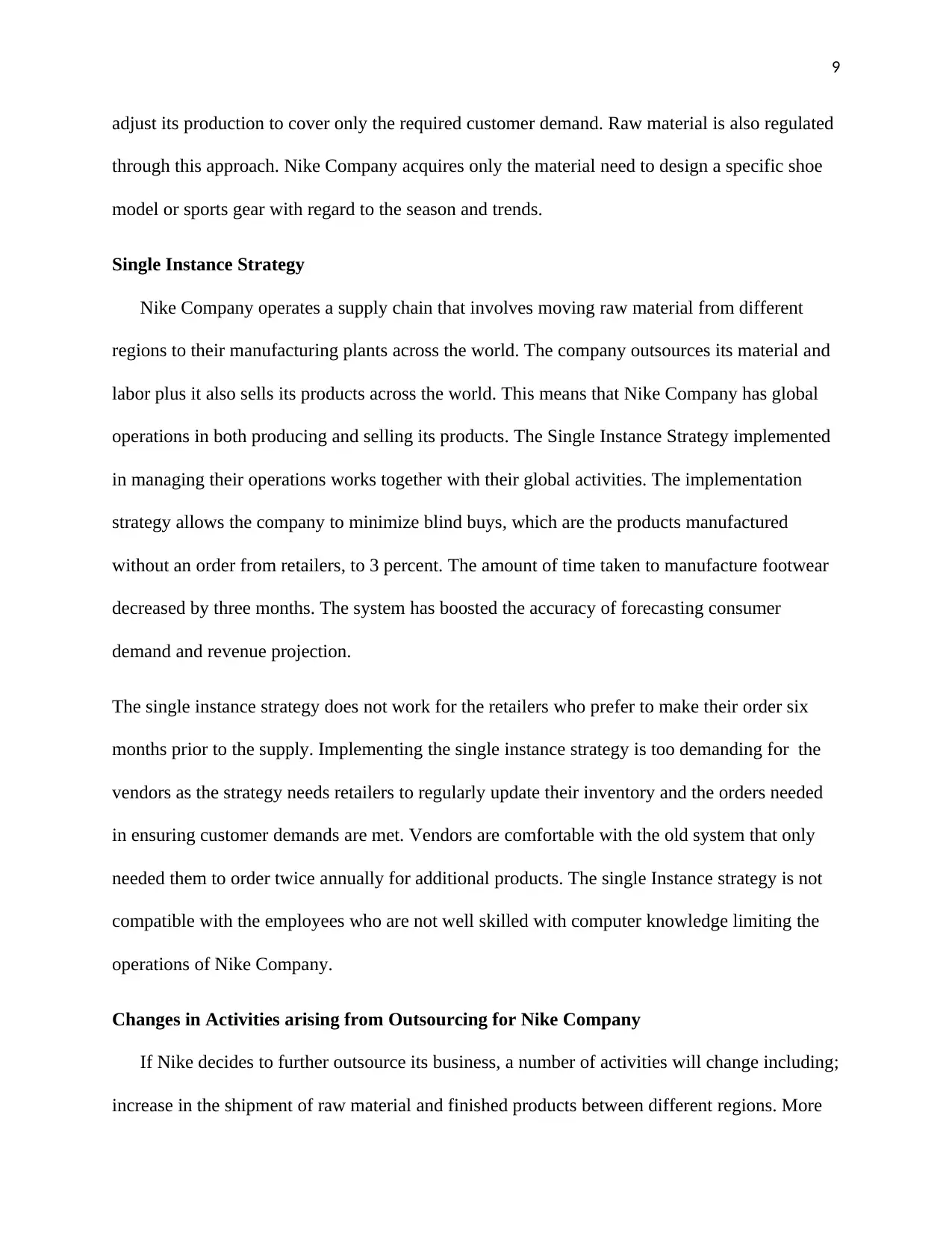
9
adjust its production to cover only the required customer demand. Raw material is also regulated
through this approach. Nike Company acquires only the material need to design a specific shoe
model or sports gear with regard to the season and trends.
Single Instance Strategy
Nike Company operates a supply chain that involves moving raw material from different
regions to their manufacturing plants across the world. The company outsources its material and
labor plus it also sells its products across the world. This means that Nike Company has global
operations in both producing and selling its products. The Single Instance Strategy implemented
in managing their operations works together with their global activities. The implementation
strategy allows the company to minimize blind buys, which are the products manufactured
without an order from retailers, to 3 percent. The amount of time taken to manufacture footwear
decreased by three months. The system has boosted the accuracy of forecasting consumer
demand and revenue projection.
The single instance strategy does not work for the retailers who prefer to make their order six
months prior to the supply. Implementing the single instance strategy is too demanding for the
vendors as the strategy needs retailers to regularly update their inventory and the orders needed
in ensuring customer demands are met. Vendors are comfortable with the old system that only
needed them to order twice annually for additional products. The single Instance strategy is not
compatible with the employees who are not well skilled with computer knowledge limiting the
operations of Nike Company.
Changes in Activities arising from Outsourcing for Nike Company
If Nike decides to further outsource its business, a number of activities will change including;
increase in the shipment of raw material and finished products between different regions. More
adjust its production to cover only the required customer demand. Raw material is also regulated
through this approach. Nike Company acquires only the material need to design a specific shoe
model or sports gear with regard to the season and trends.
Single Instance Strategy
Nike Company operates a supply chain that involves moving raw material from different
regions to their manufacturing plants across the world. The company outsources its material and
labor plus it also sells its products across the world. This means that Nike Company has global
operations in both producing and selling its products. The Single Instance Strategy implemented
in managing their operations works together with their global activities. The implementation
strategy allows the company to minimize blind buys, which are the products manufactured
without an order from retailers, to 3 percent. The amount of time taken to manufacture footwear
decreased by three months. The system has boosted the accuracy of forecasting consumer
demand and revenue projection.
The single instance strategy does not work for the retailers who prefer to make their order six
months prior to the supply. Implementing the single instance strategy is too demanding for the
vendors as the strategy needs retailers to regularly update their inventory and the orders needed
in ensuring customer demands are met. Vendors are comfortable with the old system that only
needed them to order twice annually for additional products. The single Instance strategy is not
compatible with the employees who are not well skilled with computer knowledge limiting the
operations of Nike Company.
Changes in Activities arising from Outsourcing for Nike Company
If Nike decides to further outsource its business, a number of activities will change including;
increase in the shipment of raw material and finished products between different regions. More
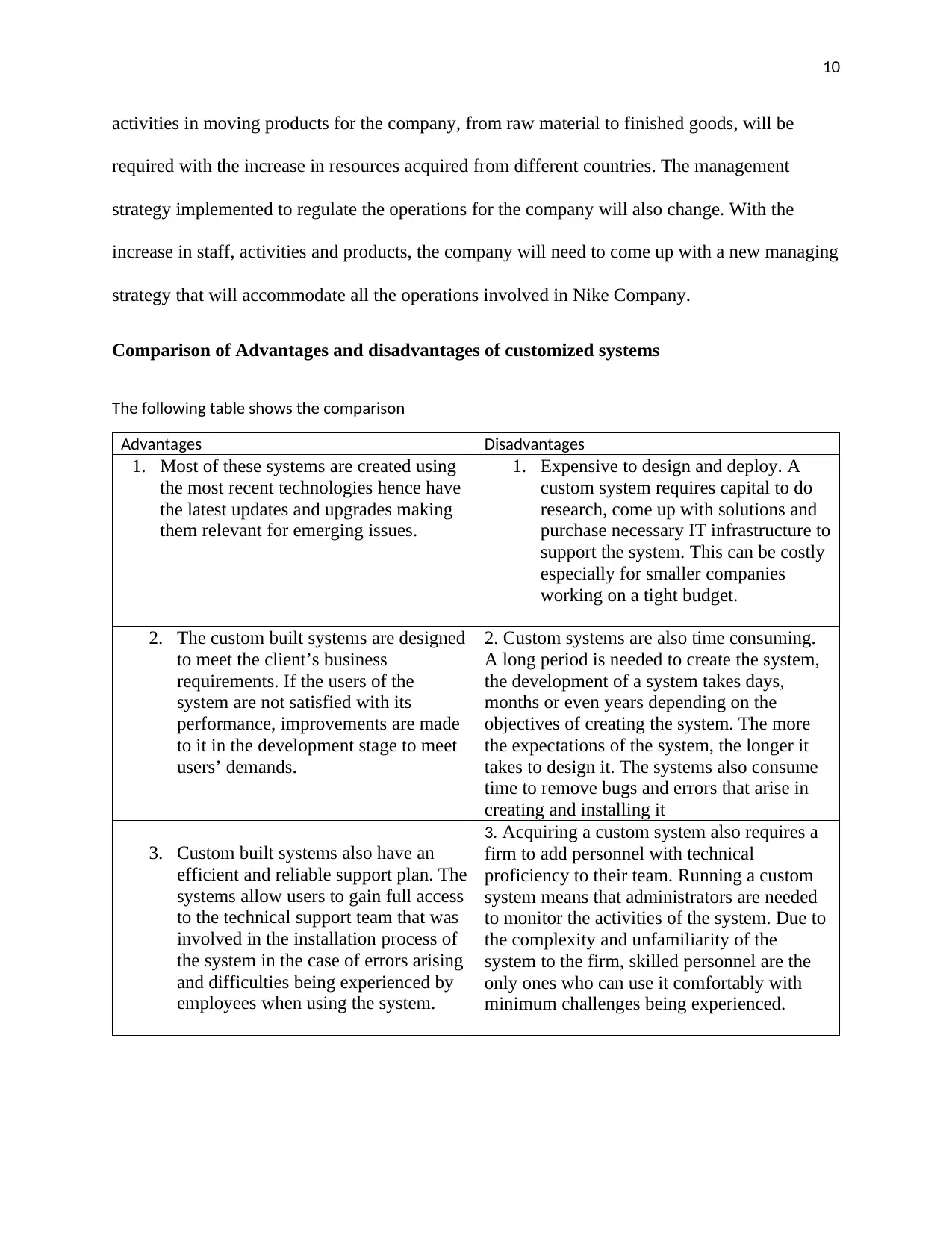
10
activities in moving products for the company, from raw material to finished goods, will be
required with the increase in resources acquired from different countries. The management
strategy implemented to regulate the operations for the company will also change. With the
increase in staff, activities and products, the company will need to come up with a new managing
strategy that will accommodate all the operations involved in Nike Company.
Comparison of Advantages and disadvantages of customized systems
The following table shows the comparison
Advantages Disadvantages
1. Most of these systems are created using
the most recent technologies hence have
the latest updates and upgrades making
them relevant for emerging issues.
1. Expensive to design and deploy. A
custom system requires capital to do
research, come up with solutions and
purchase necessary IT infrastructure to
support the system. This can be costly
especially for smaller companies
working on a tight budget.
2. The custom built systems are designed
to meet the client’s business
requirements. If the users of the
system are not satisfied with its
performance, improvements are made
to it in the development stage to meet
users’ demands.
2. Custom systems are also time consuming.
A long period is needed to create the system,
the development of a system takes days,
months or even years depending on the
objectives of creating the system. The more
the expectations of the system, the longer it
takes to design it. The systems also consume
time to remove bugs and errors that arise in
creating and installing it
3. Custom built systems also have an
efficient and reliable support plan. The
systems allow users to gain full access
to the technical support team that was
involved in the installation process of
the system in the case of errors arising
and difficulties being experienced by
employees when using the system.
3. Acquiring a custom system also requires a
firm to add personnel with technical
proficiency to their team. Running a custom
system means that administrators are needed
to monitor the activities of the system. Due to
the complexity and unfamiliarity of the
system to the firm, skilled personnel are the
only ones who can use it comfortably with
minimum challenges being experienced.
activities in moving products for the company, from raw material to finished goods, will be
required with the increase in resources acquired from different countries. The management
strategy implemented to regulate the operations for the company will also change. With the
increase in staff, activities and products, the company will need to come up with a new managing
strategy that will accommodate all the operations involved in Nike Company.
Comparison of Advantages and disadvantages of customized systems
The following table shows the comparison
Advantages Disadvantages
1. Most of these systems are created using
the most recent technologies hence have
the latest updates and upgrades making
them relevant for emerging issues.
1. Expensive to design and deploy. A
custom system requires capital to do
research, come up with solutions and
purchase necessary IT infrastructure to
support the system. This can be costly
especially for smaller companies
working on a tight budget.
2. The custom built systems are designed
to meet the client’s business
requirements. If the users of the
system are not satisfied with its
performance, improvements are made
to it in the development stage to meet
users’ demands.
2. Custom systems are also time consuming.
A long period is needed to create the system,
the development of a system takes days,
months or even years depending on the
objectives of creating the system. The more
the expectations of the system, the longer it
takes to design it. The systems also consume
time to remove bugs and errors that arise in
creating and installing it
3. Custom built systems also have an
efficient and reliable support plan. The
systems allow users to gain full access
to the technical support team that was
involved in the installation process of
the system in the case of errors arising
and difficulties being experienced by
employees when using the system.
3. Acquiring a custom system also requires a
firm to add personnel with technical
proficiency to their team. Running a custom
system means that administrators are needed
to monitor the activities of the system. Due to
the complexity and unfamiliarity of the
system to the firm, skilled personnel are the
only ones who can use it comfortably with
minimum challenges being experienced.
Secure Best Marks with AI Grader
Need help grading? Try our AI Grader for instant feedback on your assignments.
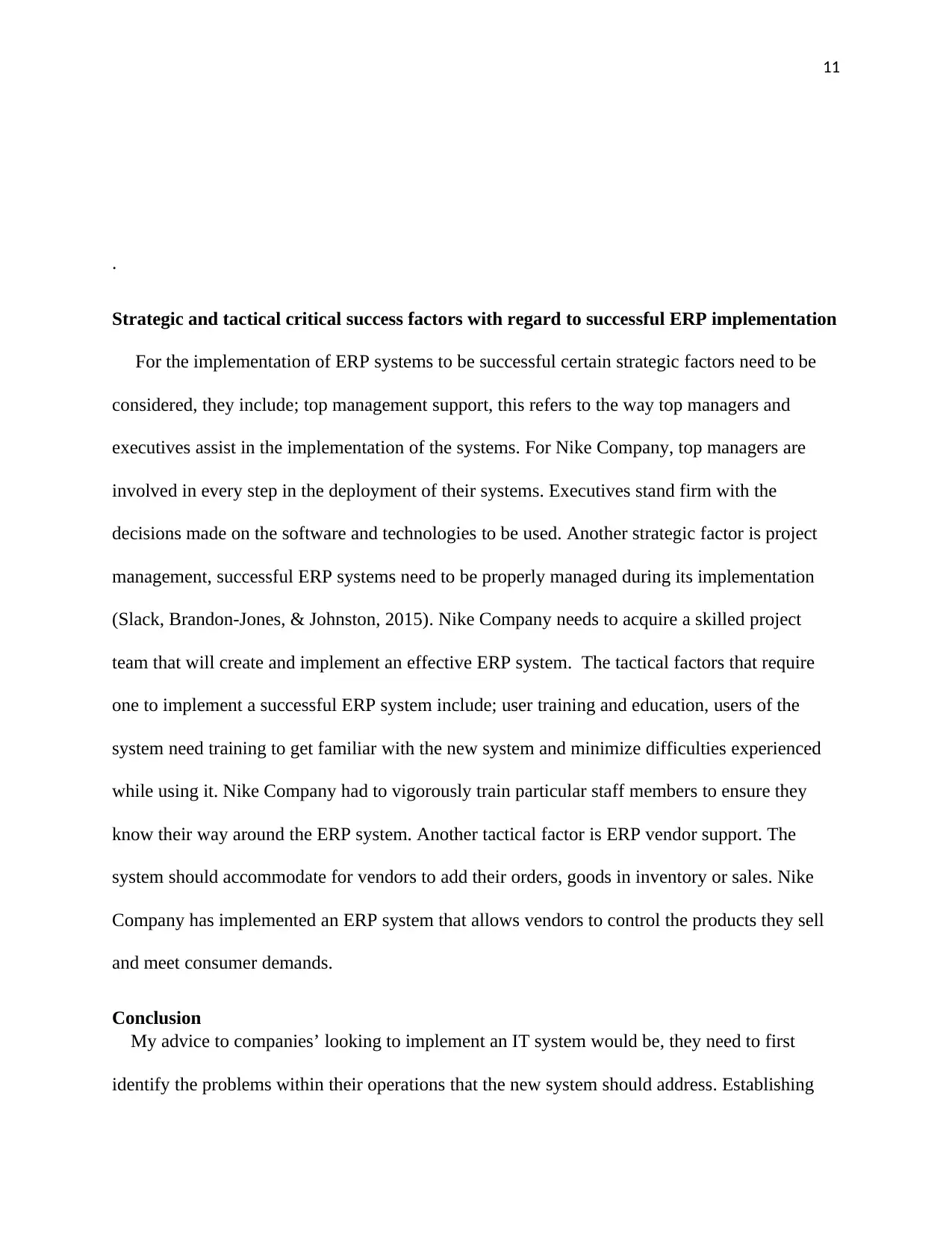
11
.
Strategic and tactical critical success factors with regard to successful ERP implementation
For the implementation of ERP systems to be successful certain strategic factors need to be
considered, they include; top management support, this refers to the way top managers and
executives assist in the implementation of the systems. For Nike Company, top managers are
involved in every step in the deployment of their systems. Executives stand firm with the
decisions made on the software and technologies to be used. Another strategic factor is project
management, successful ERP systems need to be properly managed during its implementation
(Slack, Brandon-Jones, & Johnston, 2015). Nike Company needs to acquire a skilled project
team that will create and implement an effective ERP system. The tactical factors that require
one to implement a successful ERP system include; user training and education, users of the
system need training to get familiar with the new system and minimize difficulties experienced
while using it. Nike Company had to vigorously train particular staff members to ensure they
know their way around the ERP system. Another tactical factor is ERP vendor support. The
system should accommodate for vendors to add their orders, goods in inventory or sales. Nike
Company has implemented an ERP system that allows vendors to control the products they sell
and meet consumer demands.
Conclusion
My advice to companies’ looking to implement an IT system would be, they need to first
identify the problems within their operations that the new system should address. Establishing
.
Strategic and tactical critical success factors with regard to successful ERP implementation
For the implementation of ERP systems to be successful certain strategic factors need to be
considered, they include; top management support, this refers to the way top managers and
executives assist in the implementation of the systems. For Nike Company, top managers are
involved in every step in the deployment of their systems. Executives stand firm with the
decisions made on the software and technologies to be used. Another strategic factor is project
management, successful ERP systems need to be properly managed during its implementation
(Slack, Brandon-Jones, & Johnston, 2015). Nike Company needs to acquire a skilled project
team that will create and implement an effective ERP system. The tactical factors that require
one to implement a successful ERP system include; user training and education, users of the
system need training to get familiar with the new system and minimize difficulties experienced
while using it. Nike Company had to vigorously train particular staff members to ensure they
know their way around the ERP system. Another tactical factor is ERP vendor support. The
system should accommodate for vendors to add their orders, goods in inventory or sales. Nike
Company has implemented an ERP system that allows vendors to control the products they sell
and meet consumer demands.
Conclusion
My advice to companies’ looking to implement an IT system would be, they need to first
identify the problems within their operations that the new system should address. Establishing
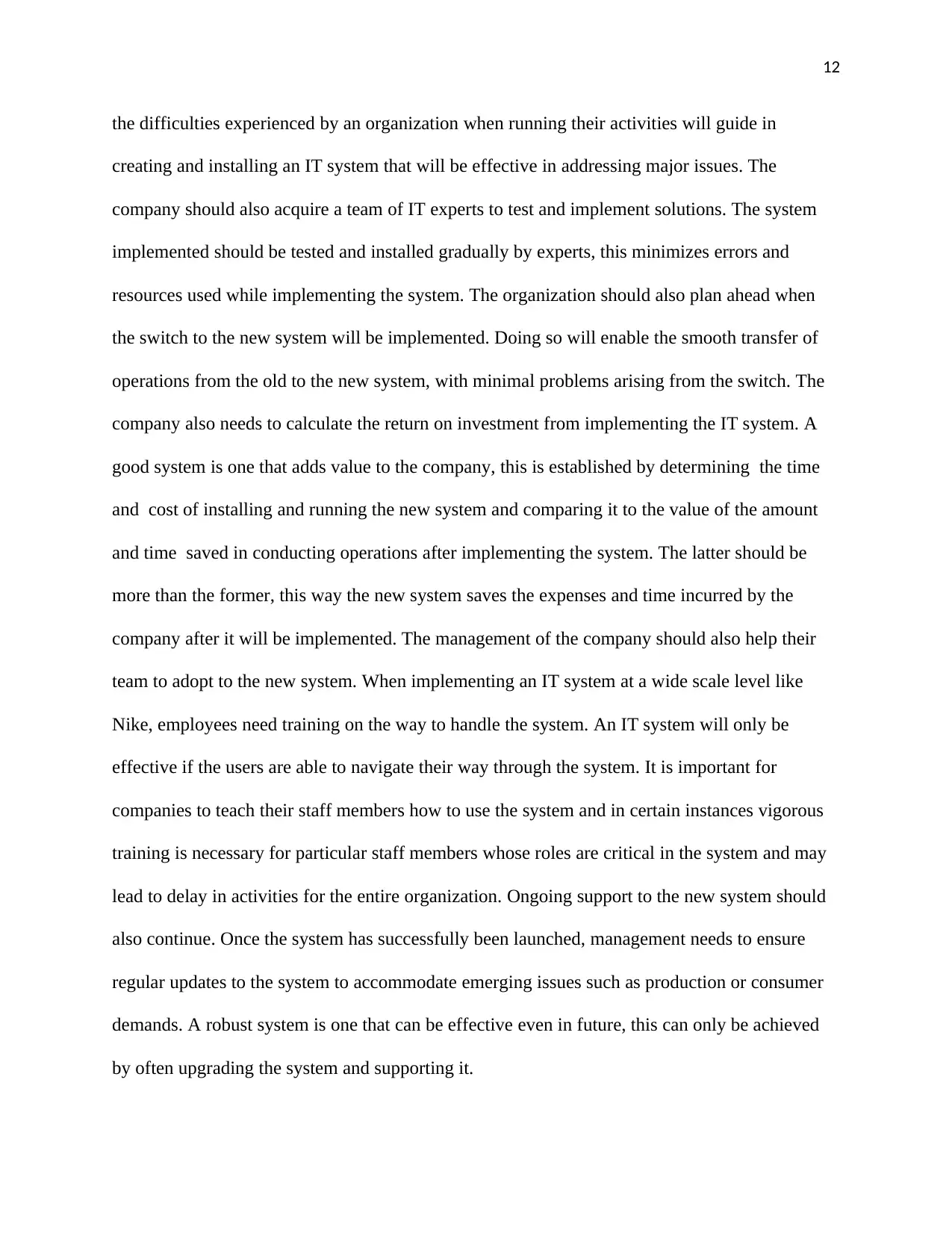
12
the difficulties experienced by an organization when running their activities will guide in
creating and installing an IT system that will be effective in addressing major issues. The
company should also acquire a team of IT experts to test and implement solutions. The system
implemented should be tested and installed gradually by experts, this minimizes errors and
resources used while implementing the system. The organization should also plan ahead when
the switch to the new system will be implemented. Doing so will enable the smooth transfer of
operations from the old to the new system, with minimal problems arising from the switch. The
company also needs to calculate the return on investment from implementing the IT system. A
good system is one that adds value to the company, this is established by determining the time
and cost of installing and running the new system and comparing it to the value of the amount
and time saved in conducting operations after implementing the system. The latter should be
more than the former, this way the new system saves the expenses and time incurred by the
company after it will be implemented. The management of the company should also help their
team to adopt to the new system. When implementing an IT system at a wide scale level like
Nike, employees need training on the way to handle the system. An IT system will only be
effective if the users are able to navigate their way through the system. It is important for
companies to teach their staff members how to use the system and in certain instances vigorous
training is necessary for particular staff members whose roles are critical in the system and may
lead to delay in activities for the entire organization. Ongoing support to the new system should
also continue. Once the system has successfully been launched, management needs to ensure
regular updates to the system to accommodate emerging issues such as production or consumer
demands. A robust system is one that can be effective even in future, this can only be achieved
by often upgrading the system and supporting it.
the difficulties experienced by an organization when running their activities will guide in
creating and installing an IT system that will be effective in addressing major issues. The
company should also acquire a team of IT experts to test and implement solutions. The system
implemented should be tested and installed gradually by experts, this minimizes errors and
resources used while implementing the system. The organization should also plan ahead when
the switch to the new system will be implemented. Doing so will enable the smooth transfer of
operations from the old to the new system, with minimal problems arising from the switch. The
company also needs to calculate the return on investment from implementing the IT system. A
good system is one that adds value to the company, this is established by determining the time
and cost of installing and running the new system and comparing it to the value of the amount
and time saved in conducting operations after implementing the system. The latter should be
more than the former, this way the new system saves the expenses and time incurred by the
company after it will be implemented. The management of the company should also help their
team to adopt to the new system. When implementing an IT system at a wide scale level like
Nike, employees need training on the way to handle the system. An IT system will only be
effective if the users are able to navigate their way through the system. It is important for
companies to teach their staff members how to use the system and in certain instances vigorous
training is necessary for particular staff members whose roles are critical in the system and may
lead to delay in activities for the entire organization. Ongoing support to the new system should
also continue. Once the system has successfully been launched, management needs to ensure
regular updates to the system to accommodate emerging issues such as production or consumer
demands. A robust system is one that can be effective even in future, this can only be achieved
by often upgrading the system and supporting it.

13
Paraphrase This Document
Need a fresh take? Get an instant paraphrase of this document with our AI Paraphraser
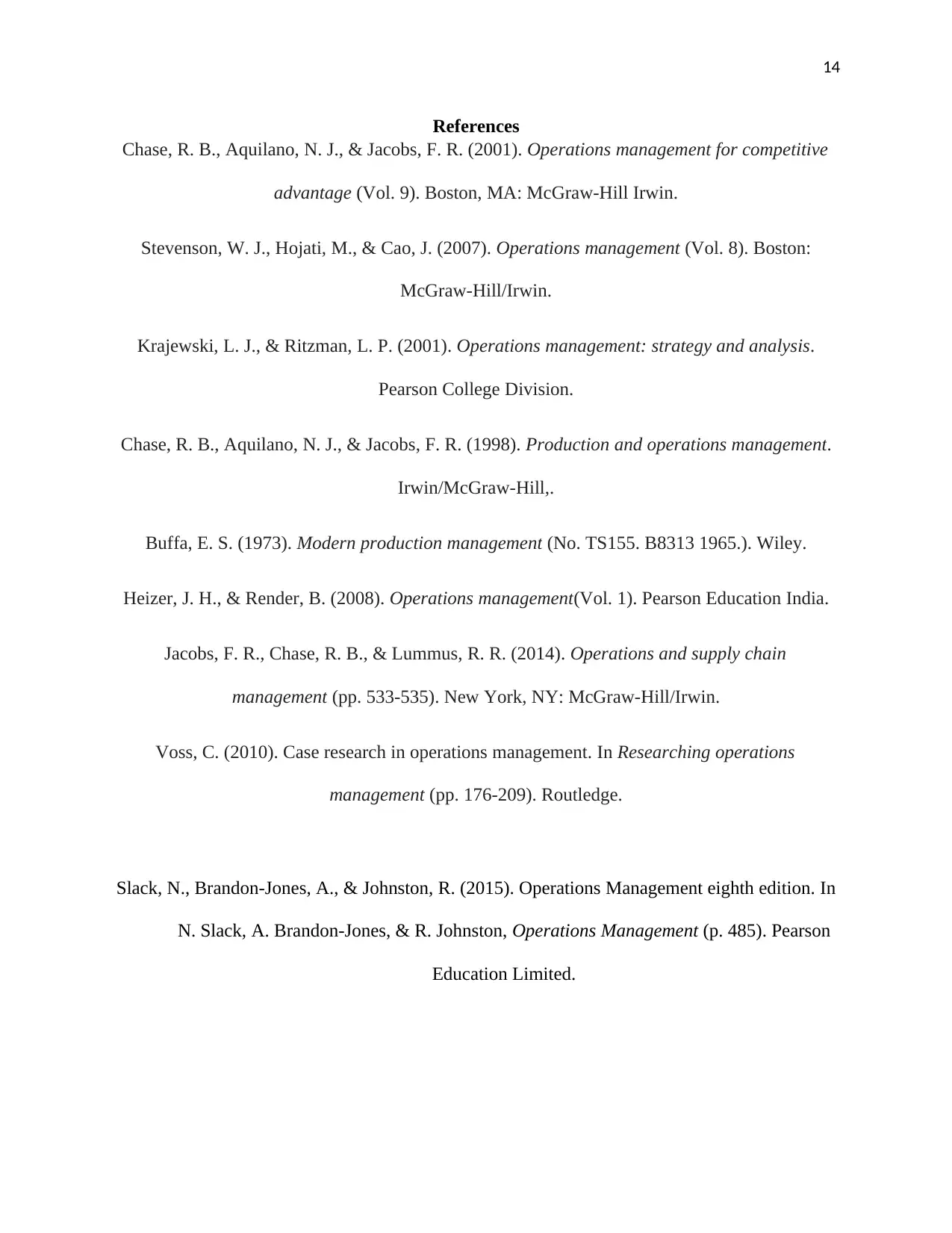
14
References
Chase, R. B., Aquilano, N. J., & Jacobs, F. R. (2001). Operations management for competitive
advantage (Vol. 9). Boston, MA: McGraw-Hill Irwin.
Stevenson, W. J., Hojati, M., & Cao, J. (2007). Operations management (Vol. 8). Boston:
McGraw-Hill/Irwin.
Krajewski, L. J., & Ritzman, L. P. (2001). Operations management: strategy and analysis.
Pearson College Division.
Chase, R. B., Aquilano, N. J., & Jacobs, F. R. (1998). Production and operations management.
Irwin/McGraw-Hill,.
Buffa, E. S. (1973). Modern production management (No. TS155. B8313 1965.). Wiley.
Heizer, J. H., & Render, B. (2008). Operations management(Vol. 1). Pearson Education India.
Jacobs, F. R., Chase, R. B., & Lummus, R. R. (2014). Operations and supply chain
management (pp. 533-535). New York, NY: McGraw-Hill/Irwin.
Voss, C. (2010). Case research in operations management. In Researching operations
management (pp. 176-209). Routledge.
Slack, N., Brandon-Jones, A., & Johnston, R. (2015). Operations Management eighth edition. In
N. Slack, A. Brandon-Jones, & R. Johnston, Operations Management (p. 485). Pearson
Education Limited.
References
Chase, R. B., Aquilano, N. J., & Jacobs, F. R. (2001). Operations management for competitive
advantage (Vol. 9). Boston, MA: McGraw-Hill Irwin.
Stevenson, W. J., Hojati, M., & Cao, J. (2007). Operations management (Vol. 8). Boston:
McGraw-Hill/Irwin.
Krajewski, L. J., & Ritzman, L. P. (2001). Operations management: strategy and analysis.
Pearson College Division.
Chase, R. B., Aquilano, N. J., & Jacobs, F. R. (1998). Production and operations management.
Irwin/McGraw-Hill,.
Buffa, E. S. (1973). Modern production management (No. TS155. B8313 1965.). Wiley.
Heizer, J. H., & Render, B. (2008). Operations management(Vol. 1). Pearson Education India.
Jacobs, F. R., Chase, R. B., & Lummus, R. R. (2014). Operations and supply chain
management (pp. 533-535). New York, NY: McGraw-Hill/Irwin.
Voss, C. (2010). Case research in operations management. In Researching operations
management (pp. 176-209). Routledge.
Slack, N., Brandon-Jones, A., & Johnston, R. (2015). Operations Management eighth edition. In
N. Slack, A. Brandon-Jones, & R. Johnston, Operations Management (p. 485). Pearson
Education Limited.
1 out of 14
Related Documents
Your All-in-One AI-Powered Toolkit for Academic Success.
+13062052269
info@desklib.com
Available 24*7 on WhatsApp / Email
![[object Object]](/_next/static/media/star-bottom.7253800d.svg)
Unlock your academic potential
© 2024 | Zucol Services PVT LTD | All rights reserved.





